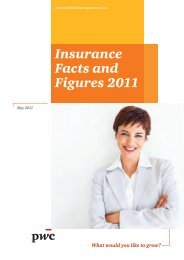Insurance facts and figures 2007 - PwC
Insurance facts and figures 2007 - PwC
Insurance facts and figures 2007 - PwC
You also want an ePaper? Increase the reach of your titles
YUMPU automatically turns print PDFs into web optimized ePapers that Google loves.
AS3.04 Capital Adequacy St<strong>and</strong>ard is a longer-term test that prescribes the capital<br />
requirement of a health benefits fund to ensure that its obligations to, <strong>and</strong> reasonable<br />
expectations of, contributors <strong>and</strong> creditors can be met under a range of adverse<br />
circumstances. The capital adequacy requirement is thus based on an ongoing view<br />
that requires a fund to show that it has sufficient capital to implement its business<br />
plans, accept new business, absorb short-term adverse events from time to time <strong>and</strong><br />
remain solvent.<br />
The interpretation of the st<strong>and</strong>ard sets out <strong>and</strong> explains the components used in<br />
applying the solvency <strong>and</strong> capital adequacy st<strong>and</strong>ards. The st<strong>and</strong>ards are based on the<br />
concepts of liability risk, asset risk <strong>and</strong> other risks.<br />
Liability risk<br />
The liability risk can be considered as the amount required to meet existing liabilities<br />
(solvency <strong>and</strong> capital adequacy st<strong>and</strong>ard) plus an amount to meet the liability<br />
associated with continuing to write business (capital adequacy st<strong>and</strong>ard). The amount<br />
required to meet existing liabilities is set as the sum of the:<br />
• Net claims liability;<br />
• Reinsurance accrued liability; <strong>and</strong><br />
• Other liabilities.<br />
The net claims liability is outst<strong>and</strong>ing claims net of reinsurance on outst<strong>and</strong>ing<br />
claims <strong>and</strong> the liability in respect of unexpired risk (determined as the contributions<br />
in advance multiplied by a specified loss ratio). Each item includes a margin <strong>and</strong><br />
includes associated claims h<strong>and</strong>ling expenses. The margin is prescribed at 10 per cent<br />
for the solvency calculation, while the capital adequacy margin is determined by the<br />
board (subject to a prescribed minimum of 12.5 per cent) based on a qualitative risk<br />
assessment of the fund’s membership base <strong>and</strong> the volatility of claims. For both the<br />
solvency <strong>and</strong> capital adequacy st<strong>and</strong>ards, the net claims liability should not be less<br />
than the reported liability.<br />
The reinsurance accrued liability is the amount due/payable from the reinsurance trust<br />
fund in the coming period in respect of members covered <strong>and</strong> benefits paid from prior<br />
periods. The liability is thus the reinsurance levy for members covered in the preceding<br />
quarter, less benefit payments that can be recovered from the reinsurance trust fund.<br />
A margin is added to the reinsurance levy (currently 10 per cent).<br />
62
















